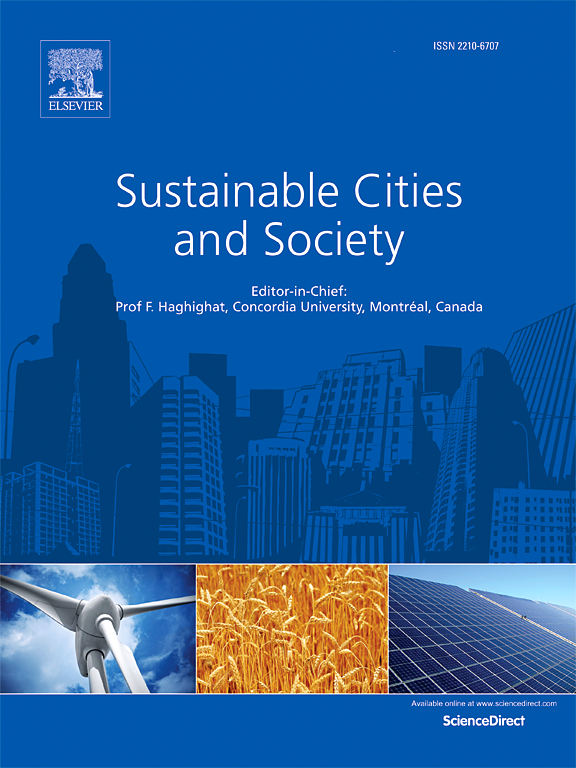基于多源数据集成的上海市公共开放空间与热环境关系研究
IF 10.5
1区 工程技术
Q1 CONSTRUCTION & BUILDING TECHNOLOGY
引用次数: 0
摘要
快速城市化加剧了城市热环境的严重程度,公共开放空间在改善城市热环境方面发挥着重要作用。以往的研究主要集中在单一类型POS的降温效应上,而很少关注多类型POS的综合降温增温效应和异质性。本文结合多源数据,对上海市的POSs进行分类和提取。通过城市地表温度的遥感影像反演,分析了上海市城市热岛的时空演变特征。通过构建评价指标体系,揭示了POS内部热环境、外部热环境与影响因素之间的相关性。结果表明:(1)上海城市热岛效应已不再局限于城市中心,而是向周边地区延伸,呈现出明显的“内凸外凹”、“南冷北热、东冷西热”的特征;(2)城市公园能在一定程度上改善热环境,但运动场和广场用地会造成小规模的UHIs。共有99.06%的城市公园具有降温效果,平均降温距离为199.33 m,平均降温强度为2.83℃。共有86.67%的体育场馆具有增温效应,影响距离(207.15 m)略大于城市公园。(3)城市公园增强不透水面指数(ENDISI)平均值对地表温度有显著的正向影响,而周长和水体比例对地表温度有显著的负向影响。方形土地平均LST与森林面积比例呈负相关,与ENDISI呈正相关。体育场馆内平均LST与其外部ENDISI呈显著正相关。当外部ENDISI降低0.0423时,体育场馆内平均LST降低1℃。(4)对于具有降温效应的冷岛空间,样点内林地比例越大,归一化植被指数(NDVI)均值越大,不透水地表比例越小,ENDISI均值越小,与外界环境的降温距离越大。样品内部地表温度每降低1.36℃,平均NDVI每增加0.29℃,外部环境平均归一化差水指数(NDWI)每降低0.09℃,外部环境平均ENDISI每增加0.04℃,样品对外部热环境的冷却幅度增加1℃。研究结果可为改善城市热环境、应对气候变化挑战提供数据依据。本文章由计算机程序翻译,如有差异,请以英文原文为准。
Research on the relationship between public open space and the thermal environment in Shanghai based on multisource data integration
Rapid urbanization has increased the severity of the urban thermal environment, and public open space (POS) plays an important role in improving the urban thermal environment. Previous studies focused on the cooling effect of a single type of POS but seldom paid attention to the comprehensive cooling/warming effect and heterogeneity of multi-type POSs. This paper combines multisource data to classify and extract the POSs in Shanghai. Through remote sensing image inversion of the urban surface temperature, the spatial and temporal evolution of urban heat islands (UHIs) in Shanghai was analysed. By constructing an evaluation index system, the correlations among the internal thermal environment, external thermal environment and influencing factors of POS are revealed. The results indicate that (1) the UHI effect in Shanghai is no longer limited to the city centre but extends to the peripheral areas, with obvious characteristics of "inner bulge and outer depression" and "south cold and north hot, east cold and west hot". (2) Urban parks can improve the thermal environment to a certain extent, but sports grounds and square land can cause small-scale UHIs. A total of 99.06 % of urban parks have cooling effects, the average cooling distance is 199.33 m, and the average cooling intensity is 2.83 °C. A total of 86.67 % of the sports venues have a warming effect, and the influence distance (207.15 m) is slightly greater than that of urban parks. (3) The average value of the enhanced impervious surface index (ENDISI) in urban parks has a significant positive effect on land surface temperature (LST), whereas the circumference and water body proportion have a significant negative effect on LST. The average LST of square land is negatively correlated with the proportion of forest area and positively correlated with the ENDISI. There was a significant positive correlation between the average LST inside the sports venue and its external ENDISI. When the external ENDISI decreases by 0.0423, the average LST inside the sports venue decreases by 1 °C. (4) For cold island spaces with cooling effects, the greater the proportions of forestland within the samples, the greater the mean values of the normalized difference vegetation index (NDVI), the smaller the proportions of impervious surface, and the smaller the mean values of the ENDISI are, the greater the cooling distances to the external environment. For every 1.36 °C decrease in the LST within the sample, every 0.29 increase in the mean NDVI, every 0.09 decrease in the mean normalized difference water index (NDWI) of the external environment, and every 0.04 increase in the mean ENDISI of the external environment, the cooling amplitude of the sample to the external thermal environment increases by 1 °C. The research results provide data that can be used to improve the urban thermal environment and cope with the challenges of climate change.
求助全文
通过发布文献求助,成功后即可免费获取论文全文。
去求助
来源期刊

Sustainable Cities and Society
Social Sciences-Geography, Planning and Development
CiteScore
22.00
自引率
13.70%
发文量
810
审稿时长
27 days
期刊介绍:
Sustainable Cities and Society (SCS) is an international journal that focuses on fundamental and applied research to promote environmentally sustainable and socially resilient cities. The journal welcomes cross-cutting, multi-disciplinary research in various areas, including:
1. Smart cities and resilient environments;
2. Alternative/clean energy sources, energy distribution, distributed energy generation, and energy demand reduction/management;
3. Monitoring and improving air quality in built environment and cities (e.g., healthy built environment and air quality management);
4. Energy efficient, low/zero carbon, and green buildings/communities;
5. Climate change mitigation and adaptation in urban environments;
6. Green infrastructure and BMPs;
7. Environmental Footprint accounting and management;
8. Urban agriculture and forestry;
9. ICT, smart grid and intelligent infrastructure;
10. Urban design/planning, regulations, legislation, certification, economics, and policy;
11. Social aspects, impacts and resiliency of cities;
12. Behavior monitoring, analysis and change within urban communities;
13. Health monitoring and improvement;
14. Nexus issues related to sustainable cities and societies;
15. Smart city governance;
16. Decision Support Systems for trade-off and uncertainty analysis for improved management of cities and society;
17. Big data, machine learning, and artificial intelligence applications and case studies;
18. Critical infrastructure protection, including security, privacy, forensics, and reliability issues of cyber-physical systems.
19. Water footprint reduction and urban water distribution, harvesting, treatment, reuse and management;
20. Waste reduction and recycling;
21. Wastewater collection, treatment and recycling;
22. Smart, clean and healthy transportation systems and infrastructure;
 求助内容:
求助内容: 应助结果提醒方式:
应助结果提醒方式:


